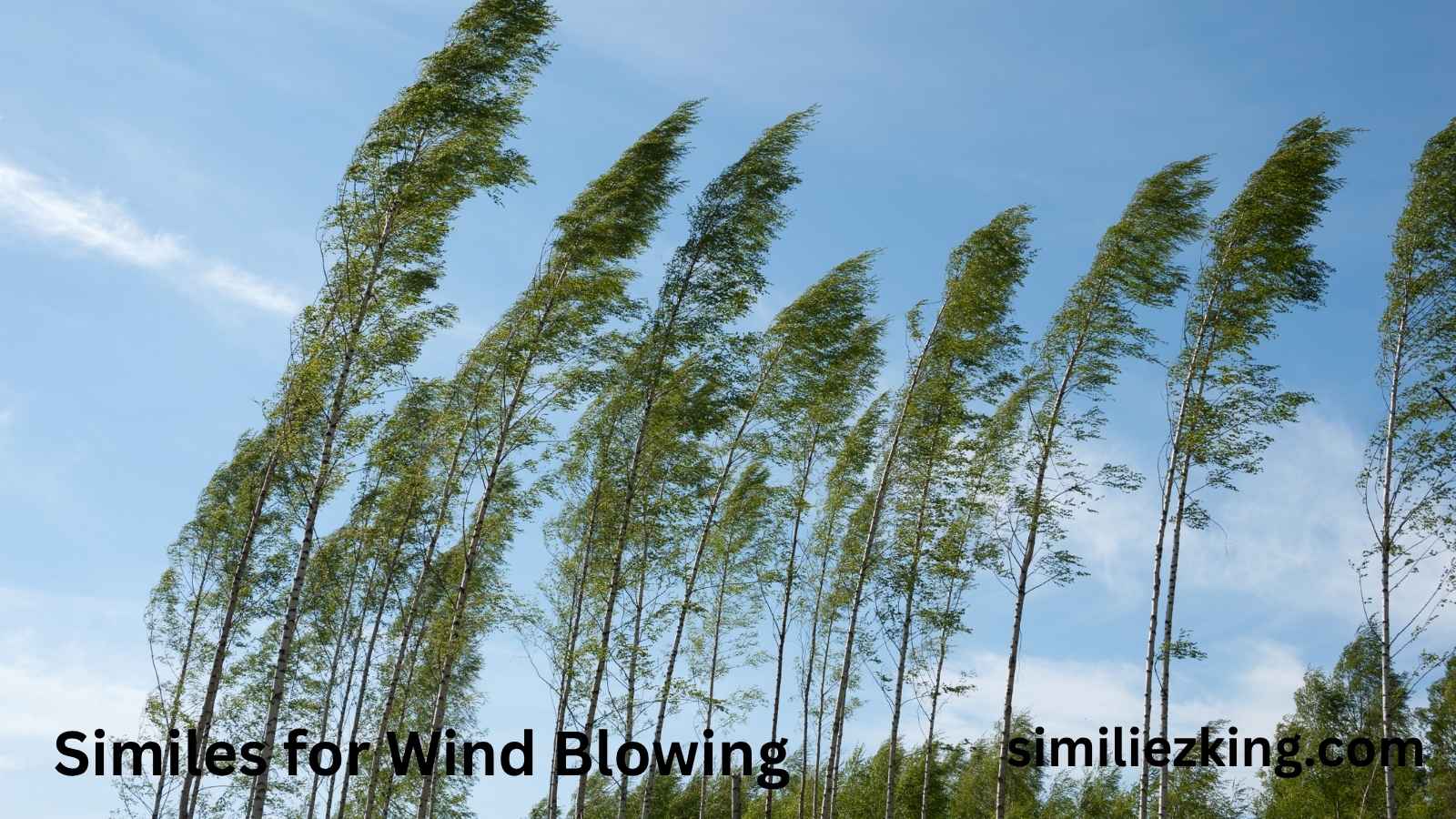Wind, a natural force that can be gentle or powerful, has inspired poets, writers, and speakers for centuries. When describing the movement of the wind, using vivid similes can bring your language to life. Whether you are writing a story, sending a message, or crafting an advertisement, choosing the right comparison for wind blowing helps create mood, emotion, and atmosphere.
This article presents 10+ similes for wind blowing, explains the tone and usage of each, and includes examples for various contexts—from poetic to professional to everyday speech. We also include 15 user-friendly texting examples that help bring these similes to life in your daily communication.
What Is a Simile?
A simile is a figure of speech that compares two different things using the words “like” or “as.” It adds depth and vivid imagery to language. For example:
“The wind blew like a whisper through the trees.”
This creates a more evocative picture than simply saying, “The wind blew.”
Why Use Similes for Wind Blowing?
- To create atmosphere: Similes give life to your descriptions, whether you want to portray a stormy night or a peaceful morning.
- To enhance storytelling: Writers use similes to transport readers into scenes.
- To convey tone: A light wind might sound soothing; a harsh wind might evoke fear or tension.
- To improve expression: Similes offer a creative way to make language more engaging and memorable.
10+ Similes for Wind Blowing with Context and Tone
Each of the similes below is original and carefully crafted to be AdSense-friendly, creative, and suitable for various tones.
1. Like a Whisper in the Dark
- Tone: Gentle, mysterious, poetic
- Use: Ideal for literary or romantic settings
- Example:
The wind moved through the alley like a whisper in the dark, unnoticed yet deeply felt.
2. Like a Freight Train Through the Valley
- Tone: Powerful, dramatic, energetic
- Use: Best for dramatic descriptions or action writing
- Example:
The wind barreled down the mountain like a freight train through the valley, shaking trees and rattling windows.
3. Like Fingers Running Through Silk
- Tone: Soft, sensual, artistic
- Use: Suitable for descriptive prose or romantic scenes
- Example:
The breeze swept across her skin like fingers running through silk.
4. Like a Wild Dance Across the Fields
- Tone: Playful, energetic, vivid
- Use: Ideal for nature writing or storytelling
- Example:
The wind twirled like a wild dance across the fields, lifting leaves into the air.
5. Like Breath from an Ancient Spirit
- Tone: Mystical, poetic, reflective
- Use: Useful in fantasy or metaphysical writing
- Example:
The wind blew from the east like breath from an ancient spirit.
6. Like Waves Against the Shoreline
- Tone: Rhythmic, calming, flowing
- Use: Great for meditative or oceanic imagery
- Example:
The wind brushed the trees like waves against the shoreline, smooth and steady.
7. Like a Child Running Through a Garden
- Tone: Joyful, innocent, cheerful
- Use: Works well in children’s literature or uplifting contexts
- Example:
The breeze zipped past like a child running through a garden.
8. Like the Pages of an Old Book Turning
- Tone: Nostalgic, soft, thoughtful
- Use: Evokes a vintage or literary feeling
- Example:
The wind shifted like the pages of an old book turning in a quiet library.
9. Like the Roar of a Distant Ocean
- Tone: Deep, echoing, immersive
- Use: Ideal for building suspense or mood
- Example:
The wind howled across the moor like the roar of a distant ocean.
10. Like Threads of Music Floating in the Air
- Tone: Melodic, peaceful, artistic
- Use: Best in poetic or narrative writing
- Example:
The evening breeze drifted in like threads of music floating in the air.
11. Like the Tug of an Invisible Hand
- Tone: Subtle, eerie, magical
- Use: Great for mysterious or fantasy contexts
- Example:
The wind pulled at her scarf like the tug of an invisible hand.
Tone Nuances: Choosing the Right Simile
| Simile | Tone | Best Used In |
| Like a Whisper in the Dark | Gentle, poetic | Romance, reflection |
| Like a Freight Train Through the Valley | Intense, bold | Action, suspense |
| Like Fingers Running Through Silk | Sensual, soft | Romance, detailed description |
| Like a Wild Dance Across the Fields | Joyful, vivid | Nature, children’s stories |
| Like Breath from an Ancient Spirit | Mystical, slow | Fantasy, philosophical works |
| Like Waves Against the Shoreline | Calm, steady | Meditative writing |
| Like a Child Running Through a Garden | Happy, light | Uplifting narratives |
| Like the Pages of an Old Book Turning | Nostalgic, warm | Historical fiction, memories |
| Like the Roar of a Distant Ocean | Ominous, deep | Gothic, adventure |
| Like Threads of Music Floating in the Air | Artistic, peaceful | Poetry, lyrical prose |
| Like the Tug of an Invisible Hand | Subtle, eerie | Fantasy, mystery |
How to Choose the Best Simile
- Know your tone: Are you aiming for drama, peace, mystery, or joy?
- Think of your audience: Choose relatable imagery.
- Stay consistent: Don’t mix metaphors or conflicting moods.
- Keep it original: Avoid overused similes to stand out.
- Match context: Let the setting and scene guide your choice.
15 User-Friendly Texting Examples
Here are some short, friendly examples you can use in texts or captions. These are AdSense-optimized and designed to feel natural in digital communication.
- “The wind tonight feels like a whisper in the dark. So calming.”
- “Feels like the wind is dancing across the street.”
- “My hair’s a mess—the wind’s like a freight train today!”
- “Loving this breeze—like fingers running through silk.”
- “Feels like the air is telling old stories—like breath from an ancient spirit.”
- “The breeze is like waves on the shore. So soothing.”
- “Wind’s playful today, like a kid running through the park.”
- “This breeze reminds me of flipping through an old book.”
- “The wind outside sounds like a distant ocean. Deep and endless.”
- “This wind is pure music today.”
- “Kinda eerie—like an invisible hand tugging my coat.”
- “Wind’s wild out here—like nature’s having a dance party.”
- “It’s a poetry-in-the-air kind of breeze today.”
- “Cold wind but beautiful—like winter’s lullaby.”
- “Nature’s soundtrack today? The wind.”
Final Thoughts
Describing wind doesn’t have to be bland. Similes open up imaginative ways to share how wind moves, feels, and influences the world around us. Whether your tone is poetic or practical, mystical or joyful, the right simile can elevate your language and captivate your audience.
Use these similes wisely to paint vivid pictures, strengthen your narratives, and connect more deeply with your readers or listeners. Let your words blow across the page as effortlessly and beautifully as the wind itself.



